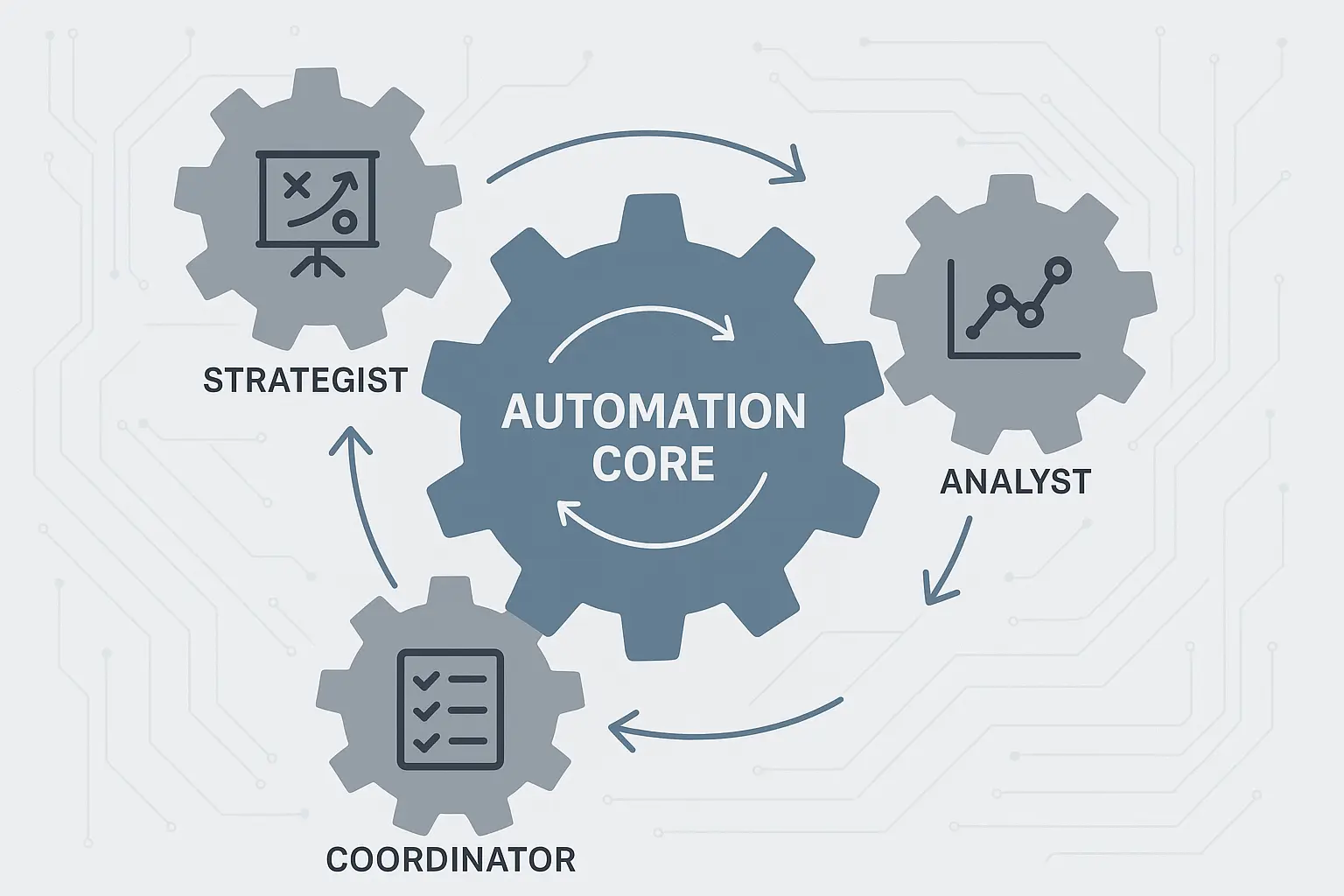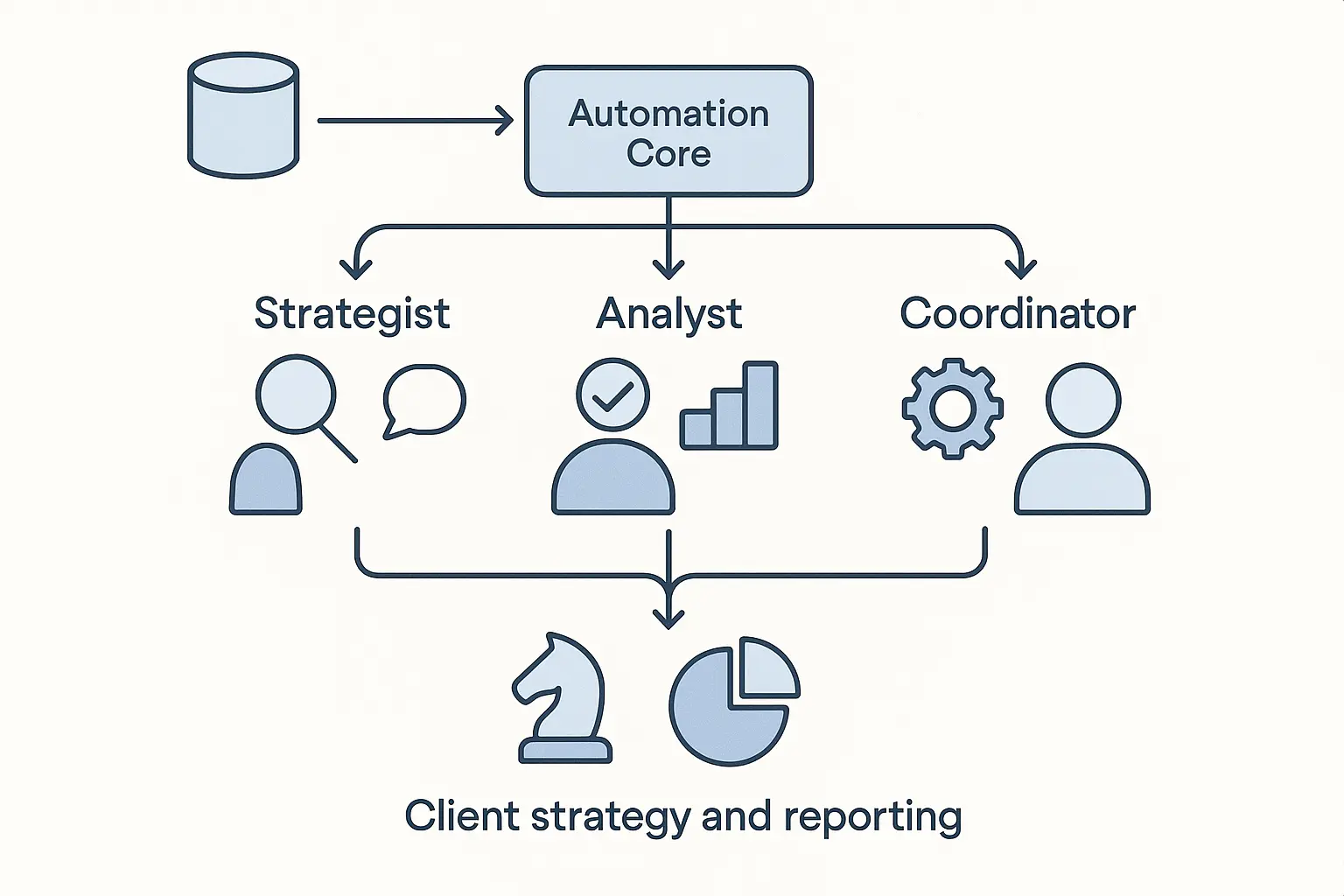Your senior SEO lead, the one you hired for their brilliant strategic mind, just spent four hours manually pulling keyword data and formatting it for a client report. Across the office, your junior specialist is staring blankly at a spreadsheet, overwhelmed by conflicting data from three different tools.
Sound familiar?
For many growing agencies, this is the daily reality: you invest in top talent to drive client growth, only to watch them get bogged down by the very tasks meant to enable their work. The traditional SEO team structure—built for a world of manual processes—is cracking under the pressure of modern client demands and an ever-expanding digital landscape.
The problem isn’t your people; it’s the framework they’re working in. It’s time for a fundamental shift—a new model that places automation at its core to redefine roles and unlock human potential.
The Old Model Is Broken. The Data Proves It.
The classic agency team often looks like a pyramid: a senior manager at the top, a few mid-level specialists executing, and junior members handling the groundwork. This worked when SEO was simpler. Today, it’s a recipe for burnout and inefficiency.
Consider the new reality:
-
The Talent Gap: According to a 2023 industry survey, 61% of marketing leaders find it “very” or “extremely” difficult to hire skilled talent. A model that requires constant hiring of expensive, senior-level experts is no longer sustainable.
-
The Task Overload: Research shows that SEO professionals spend up to 50% of their time on routine, administrative tasks like reporting, rank tracking, and site monitoring. This is a colossal waste of strategic brainpower.
-
The Complexity Explosion: SEO is no longer just about keywords and backlinks. It’s an omnichannel discipline that integrates with content, social media, and paid advertising. A siloed team structure simply can’t keep up.
The old model forces your most valuable strategists to act like data entry clerks, while your emerging talent lacks the automated systems needed to be effective. The result: scalability grinds to a halt.
The Paradigm Shift: From People-Powered to Automation-Enabled
The solution isn’t to replace humans with AI. It’s to build a “human-in-the-loop” system where technology handles repetition at scale, freeing up your team to focus on what they do best: thinking, strategizing, and building client relationships.
In this model, an AI-powered automation engine sits at the core of your operations. It handles the 90% of SEO that is process-driven—technical audits, data collection, rank monitoring, and initial content briefing. Your human experts then engage with this engine’s output, providing the crucial 10% of strategy, interpretation, and creativity that drives real results.
This fundamentally changes how you structure your team.

Instead of hiring for tasks, you hire for functions. Roles are no longer defined by seniority but by their relationship to the automation core, creating a more agile, scalable, and effective structure.
Redefining Roles for the AI-Powered Agency
In an automation-first environment, the traditional titles of “SEO Manager” or “SEO Specialist” become less relevant. In their place, three core functions emerge, each with a distinct purpose.
The SEO Strategist: The Architect
As your high-level thinker and client-facing leader, the Strategist is freed from the drudgery of manual data pulls and report building, letting them dedicate their time to high-value work.
Primary Responsibilities:
-
Answering “Why?”: Why are we pursuing this content pillar? Why should we focus on this market segment?
-
Client Relationship Management: Translating business goals into a comprehensive SEO and omnichannel growth strategy.
-
Creative Problem-Solving: Identifying new opportunities, analyzing competitor strategies, and making high-stakes decisions.
-
Cross-Channel Integration: Ensuring SEO efforts align with paid search, social media, and broader marketing campaigns.
The Strategist uses insights from the automation core and the Analyst to guide the overarching strategy. They are the human expert your clients pay for, and this model lets them focus entirely on that role.
The SEO Analyst: The Interpreter
The Analyst is the crucial bridge between raw data and strategic insight. While an AI engine can collect terabytes of information, it takes a human eye to understand the nuance, spot emerging trends, and ask the right questions.
Primary Responsibilities:
-
Answering “What does this mean?”: What story is this traffic drop telling us? What is the real intent behind this cluster of keywords?
-
Data Validation: Ensuring the outputs from automated tools are accurate and contextually relevant.
-
Insight Generation: Digging into automated reports to find the “aha moments” that inform the Strategist.
-
Performance Analysis: Connecting SEO metrics to client business outcomes, like leads and revenue.
The Analyst prevents the “garbage in, garbage out” problem. They ensure the Strategist is working with clean, meaningful data—making the entire operation smarter and more effective.
The SEO Coordinator: The Conductor
The Coordinator is the operational heart of the team. They manage the automation engine, ensuring that workflows run smoothly and that tasks are executed efficiently and on time.
Primary Responsibilities:
-
Answering “How does this get done?”: How do we deploy this technical fix across 50 client sites? How do we scale our content briefing process?
-
Workflow Management: Setting up, running, and monitoring automated tasks like site crawls, rank tracking, and competitor analysis.
-
Quality Control: Reviewing deliverables (like AI-generated content briefs or technical audit reports) before they move to the next stage.
-
Resource Management: Acting as the central hub for project execution, ensuring the right tasks are assigned and completed.
This role is the key to scalability. An effective Coordinator, armed with the right tools, can manage execution for a dozen clients—a workload that would require a small army in a traditional model. Handling this level of execution can be demanding, which is why many agencies look to partners for white-label SEO fulfillment to serve this function.
Putting It Into Practice: A Phased Approach to Growth
You don’t need to hire three new people tomorrow. This model is designed to scale with you.
-
Phase 1 (Solo / Small Team): One person wears all three hats—Strategist, Analyst, and Coordinator—using automation to amplify their own output.
-
Phase 2 (Growing Agency): You might hire a junior team member to take on the Analyst and Coordinator roles, freeing up your senior talent to be the dedicated Strategist. This is a common point to explore SEO outsourcing for agencies to fill execution gaps without adding headcount.
-
Phase 3 (Scaling Agency): You have dedicated team members in each of the three core functions, creating a powerful and efficient growth engine.

The beauty of this model is its flexibility. It lets you add capacity precisely where you need it, whether through hiring or strategic partnerships, without being locked into a rigid, outdated hierarchy.
The Future is Efficient, Scalable, and Human
Structuring your team around an automation core isn’t about cutting costs or replacing people. It’s about creating a more resilient, profitable, and fulfilling work environment.
When you elevate your experts to focus on strategy and empower your team with intelligent automation, you unlock a new level of growth. Clients get better results, your agency becomes more profitable, and your team members are engaged in the challenging, creative work they were hired to do.
Stop asking your strategists to be reporters. Stop asking your juniors to tame data chaos without the right tools. It’s time to build a team structure for the future of SEO.
Frequently Asked Questions (FAQ)
Q1: Does this automation-centric model mean I need fewer people on my SEO team?
A: Not necessarily. It means your team can accomplish significantly more. Instead of a five-person team managing five clients, this model might enable that same team to deliver superior results for 15 clients. It’s about increasing capacity and value, not just cutting headcount.
Q2: What kinds of AI and automation tools are essential for this model?
A: The core toolkit typically includes platforms for automated technical SEO audits and monitoring (e.g., crawling, site speed checks), AI-assisted keyword research and content brief generation, automated rank tracking and performance reporting, and project management systems to orchestrate workflows.
Q3: How can I implement this if I’m a one-person agency or freelancer?
A: Start by being your own Strategist, Analyst, and Coordinator. Identify your most time-consuming, repetitive tasks (like weekly reporting or initial site audits) and find tools to automate them first. Doing so frees up your time to focus on client strategy and business development, letting you scale your client base before you even make your first hire.
Q4: Is this model more expensive to set up than a traditional team?
A: The initial investment in software or a platform partner can seem significant, but it’s often far less than the cost of hiring a senior SEO specialist, which can exceed $80,000-$100,000 per year. When you factor in the increased efficiency and the ability to scale without proportional hiring, the ROI on an automation-first model is typically much higher.
Ready to explore how a re-engineered operational model can reshape your service delivery? Discover the possibilities of a scalable SEO partnership for agencies built for the future.

